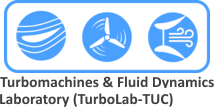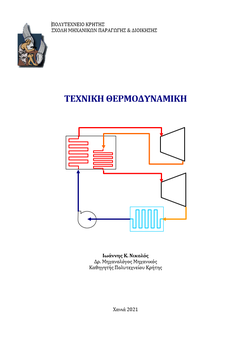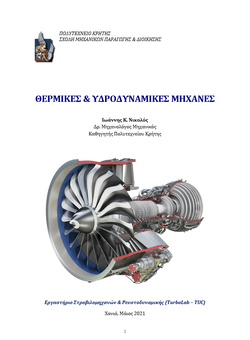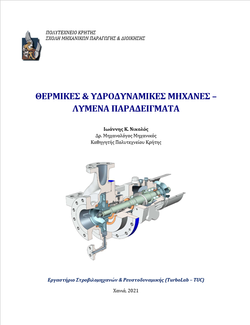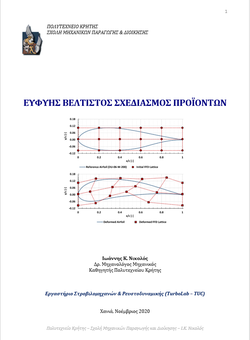The Turbomachines & Fluid Dynamics Laboratory (TurbLab-TUC) supports the teaching of undergraduate and postgraduate courses, as well as the supervision of Diploma, M.Sc., and Ph.D. Theses, in subjects related to the educational and research fields of the Laboratory.
Undergraduate Courses
Thermodynamics
Introduction - Thermodynamic systems & control volumes - Macroscopic vs. microscopic point of view - Thermodynamic equilibrium - Thermodynamic processes & cycles - Equality of temperature - The Zeroth Law of Thermodynamics - Temperature scales - The pure substance - Gases & vapors - Constitutional Equations - Ideal Gas equation - Thermodynamic work & heat - Heat transfer modes - Heat reservoirs - The First Law of Thermodynamics (closed & open thermodynamic systems) - Conservation of mass - Internal Energy - Enthalpy - Specific heats - The internal energy, enthalpy & specific heat of ideal gases - Heat engines & refrigerators - Reversible & Irreversible processes - The CARNOT cycle - The Thermodynamic Temperature Scale - The Ideal Gas Temperature Scale - Entropy - The Inequality of Clausius - GIBBS equations - Entropy change in closed systems - Entropy generation - Principle of the Increase of Entropy - Entropy change of an Ideal Gas - The Second Law of Thermodynamics (closed & open systems) - Irreversibility & Availability - HELMHOLTZ function - GIBBS function - MAXWELL equations - Tds equations - Thermodynamics of two-phases - CLAUSIUS–CLAPEYRON equation - T-s diagram of water - h-s diagram of water (MOLLIER diagram) - Thermodynamic Tables - Isentropic efficiencies - The RANKINE cycle - The OTTO & DIESEL cycles.
Thermal & Hydrodynamic Engines
CHAPTER 1: INTRODUCTION
History of Internal Combustion Engines. History of Gas Turbines. Applications of Internal Combustion Engines. Basic principles of Gas Turbines. Basic principles of Pumps. Basic principles of Hydro-turbines. Propellers. Water jet propulsion. Hydrodynamic couplings.
CHAPTER 2: GAS TURBINES
Compressors. The radial-flow compressor. The axial-flow compressor. Turbines. Basic principles of turbines. Design characteristics. Power turbines. Combustion chamber (combustor). Various types of combustion chambers. The design and operation of a combustion chamber. Fuel injection. Methods for reducing pollutant emissions in gas turbines.
CHAPTER 3: FUNDAMENTAL EQUATIONS FOR TURBOMACHINES
Energy balance. The incompressible and the compressible fluid. Coordinate systems and velocity triangles. Torque development at a turbomachine blading. The blade element; the turbine case; the compressor case. Application of blade element methodology to radial flow hydrodynamic turbomachines. The impeller of a radial flow pump. The runner of a radial flow hydro-turbine. Flow with zero work exchange inside a turbomachine. Zero developed torque – conservation of angular momentum. The radial diffuser and the design principle of the spiral-like volute. Stationary blades – change of angular momentum inside the guide vanes of a hydro-turbine. Using the blade element concept in axial flow impellers. The impeller of an axial flow pump. The rotor of a horizontal-axis wind-turbine. The geometric characteristics of turbomachines. The meridional section of a pump impeller. Francis hydro-turbines. Multi-stage turbomachines. Isentropic efficiencies. Non-dimensional parameters. Flow coefficient. Load coefficient (or work coefficient or loading factor). Degree of reaction; degree of reaction for incompressible flow turbomachines; degree of reaction for compressible flow turbomachines. Diffusion factor.
CHAPTER 4: GAS TURBINE THERMODYNAMIC CYCLES
Fundamental thermodynamic cycles of shaft-power gas turbines. Ideal air standard basic cycle (Joule - Brayton cycle). Non-ideal air standard basic cycle. Actual medium basic cycle. Air equivalent basic cycle. Modified gas turbine cycles. Gas turbine with regenerator. Steam-injected gas turbine cycle. Evaporative-regenerative gas turbine cycles. Gas turbine with intercooling. Gas turbine with reheat. Gas turbine with intercooling, reheat & regeneration. Closed-cycle gas turbines. Operation diagrams. Compressor map. Turbine map. Power and torque characteristic curves.
CHAPTER 5: RADIAL-FLOW PUMPS
Types of redial-flow pumps. Single-stage, single-entry pumps with volute casing. Single-stage, double-entry pumps with volute casing. Multistage, single-entry pumps. Submersible pumps. Major parts of a single-stage, single-entry pump with volute casing. General equations. Total Head. Power. Velocity triangles. Optimum flow rate. Ideal and theoretical characteristic curves. Non-dimensional quantities. Hydraulic efficiency. Volumetric efficiency. Mechanical efficiency. Total efficiency. Characteristic curves of a radial-flow pump. Variation of characteristic curves with rotational speed. The pumping circuit. Parallel and series pump operation.
Postgraduate Courses
- Intelligent Optimal Product Design
- Computational Mechanics Software (in cooperation)
- Computational Methods in Fluid Dynamics & Heat Transfer
Intelligent Optimal Product Design
CHAPTER 1: Introduction to Optimum Design
CHAPTER 2: Parametric Curves & Surfaces
Parametric form of curves and surfaces. Implicit and parametric form of curves. The analogy between parametric curve shape and particle trajectory. Three-dimensional and multidimensional parametric curves. Implicit and parametric form of surfaces. Calculation of a vertical vector on a parametric surface. Comparison of implicit and parametric representations. Bézier curves & surfaces. The use of polynomials for the parametric definition of random curves. Bézier curves. The geometric analogy of Bézier curves. Properties of the Bernstein polynomial. Derivatives for the Bézier curves. DeCasteljau algorithm. Properties of Bézier curves. Rational Bézier curves. The use of homogenious coordinates for the rational Bézier curves. Bézier surfaces. Rational Bézier surfaces. Piecewise functions. B-spline basis functions. Properties of the B-spline functions. Knot vectors. Bibliography.
CHAPTER 3: Introduction to Optimal Design
The design value. Design variables [independent design variables, dependent design variables, state variables, operational variables, external or environmental variables]. Types of constraints. Definition of the Optimal Design Problem. The difficulties in finding the optimal solution. Single-objective optimization methods. Non-derivative methods. Random-search method. Random-walk method. Simulated Annealing. Tabu-Search. Evolutionary Algorithms (EAs).
CHAPTER 4: Introduction to Evolutionary Algorithms (EAs)
Historic review of Evolutionary Algorithms. A short review of genetics. Terminology from Biology. Analytic description of a simple Genetic Algorithm. Crossover & Mutation. Schemata. Comparison with other optimization methodologies. Applications. Bibliography.
CHAPTER 5: Evolutionary Algorithms' Operators
A typical Genetic Algorithm (GA) with real-number coding. Crossover operators. Mutation operators. Selection operators. Selective pressure. Proportional Selection. Tournament Selection. Linear Ranking Selection. (μ, λ) & (μ+λ) Selection. Comparison between selection operators. Optimal combination between crossover, mutation and selection operators in various EA types. Management of constraints. Binary versus real coding.
CHAPTER 6: Evolution Strategies (ES)
Historic review of Evolution Strategies (ES). Initial form of ES. Evolution of (μ+λ) ES and (μ, λ) ES. Comparison between Evolution Strategies and Genetic Algorithms. Interaction between Evolution Strategies and Genetic Algorithms.
CHAPTER 7: Differential Evolution (DE) algorithm
General Characteristics. Mutation operator. Crossover operator. Selection operator. A modified donor scheme.
CHAPTER 8: Evolutionary Algorithms for Multi-Objective Optimization problems
Introduction. Definition of a Multi-Objective Optimization Problem. Single- and Multi-Objective Optimization. Different methods. The Pareto front. "After-type" optimization methods. The use of EAs in multi-objective optimization problems. Vector Evaluated Genetic Algorithm. Non–Dominated Sorting Genetic Algorithm.
CHAPTER 9: Structured populations & Parallel Evolutionary Algorithms (PEAs)
Introduction. Parallel architecture of computers. Panmictic EAs. Structured EAs. Hybrid PEAs. Advantages of PEAs.
CHAPTER 10: Artificial Neural Networks (ANNs)
CHAPTER 11: Combination of Evolutionary Algorithms & Artificial Neural Networks
CHAPTER 12: Case Studies
Parametric design of an S-Duct intake. Parametric design of wind-turbine blades. An Evolutionary Algorithm used for the solution of the Time-Table Problem of a University Department. Use of ANNs as surrogate models inside a Differential Evolution algorithm. Bibliography.
